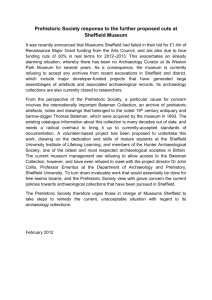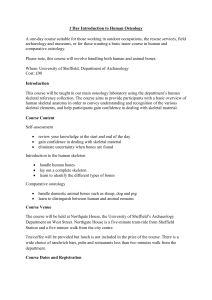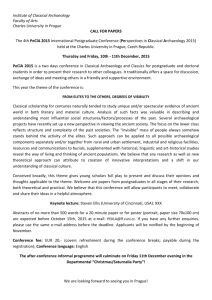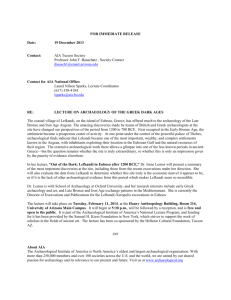aapt80
advertisement
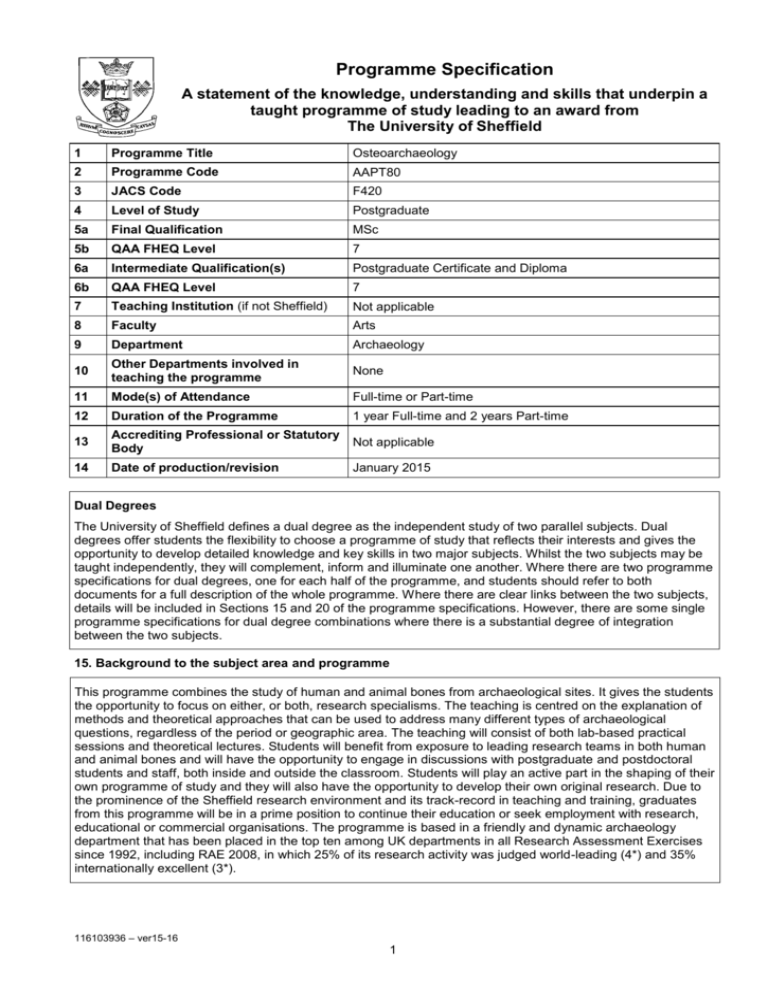
Programme Specification A statement of the knowledge, understanding and skills that underpin a taught programme of study leading to an award from The University of Sheffield 1 Programme Title Osteoarchaeology 2 Programme Code AAPT80 3 JACS Code F420 4 Level of Study Postgraduate 5a Final Qualification MSc 5b QAA FHEQ Level 7 6a Intermediate Qualification(s) Postgraduate Certificate and Diploma 6b QAA FHEQ Level 7 7 Teaching Institution (if not Sheffield) Not applicable 8 Faculty Arts 9 Department Archaeology 10 Other Departments involved in teaching the programme None 11 Mode(s) of Attendance Full-time or Part-time 12 Duration of the Programme 1 year Full-time and 2 years Part-time 13 Accrediting Professional or Statutory Body Not applicable 14 Date of production/revision January 2015 Dual Degrees The University of Sheffield defines a dual degree as the independent study of two parallel subjects. Dual degrees offer students the flexibility to choose a programme of study that reflects their interests and gives the opportunity to develop detailed knowledge and key skills in two major subjects. Whilst the two subjects may be taught independently, they will complement, inform and illuminate one another. Where there are two programme specifications for dual degrees, one for each half of the programme, and students should refer to both documents for a full description of the whole programme. Where there are clear links between the two subjects, details will be included in Sections 15 and 20 of the programme specifications. However, there are some single programme specifications for dual degree combinations where there is a substantial degree of integration between the two subjects. 15. Background to the subject area and programme This programme combines the study of human and animal bones from archaeological sites. It gives the students the opportunity to focus on either, or both, research specialisms. The teaching is centred on the explanation of methods and theoretical approaches that can be used to address many different types of archaeological questions, regardless of the period or geographic area. The teaching will consist of both lab-based practical sessions and theoretical lectures. Students will benefit from exposure to leading research teams in both human and animal bones and will have the opportunity to engage in discussions with postgraduate and postdoctoral students and staff, both inside and outside the classroom. Students will play an active part in the shaping of their own programme of study and they will also have the opportunity to develop their own original research. Due to the prominence of the Sheffield research environment and its track-record in teaching and training, graduates from this programme will be in a prime position to continue their education or seek employment with research, educational or commercial organisations. The programme is based in a friendly and dynamic archaeology department that has been placed in the top ten among UK departments in all Research Assessment Exercises since 1992, including RAE 2008, in which 25% of its research activity was judged world-leading (4*) and 35% internationally excellent (3*). 116103936 – ver15-16 1 16. Programme aims According to our aims students will: 1. recognize the potential of the study of human and animal bones for our understanding of past human societies; 2. realise the importance of addressing issues related to the study of human and animal bones at the fieldwork stage; 3. learn the main methods for the study of human and animal bones from archaeological sites; 4. become familiar with the main topics of debate in osteoarchaeology; 5. develop practical and theoretical skills that they will able to apply in their future careers; 6. enhance their communication and presentation skills and become accustomed to discussion and debate of research issues; 7. study and research in an informal but at the same time stimulating environment; 8. develop skills and knowledge that will make them suited for further education and/or employment; 9. learn to work collaboratively in an internationally oriented environment; 10. develop their own independent ideas for the future of research, in osteoarchaeology and beyond. 17. Programme learning outcomes Knowledge and understanding: Students of this programme will learn: K1 which are the important issues to consider in the recovery of bones from archaeological sites. K2 which are the main biases affecting bone assemblages (e.g. cultural choice, human intervention, taphonomy, excavation and curation). K3 what is the range of current standards and methods for recording, analysis and interpretation in osteoarchaeology. K4 how osteoarchaeological results can be integrated with other lines of evidence of archaeological (and other) research. K5 how to engage in theoretical debates on the interpretation of bone remains in archaeology. Skills and other attributes: Students of this programme will learn: S1 to identify and analyse archaeological bones, in terms of taxonomic, anatomical, age, sex, morphometrical and pathological characteristics, as well as signs of natural and human modification. S2 to process and analyse critically osteoarchaeological data. S3 to write reports about bone assemblages from archaeological sites. S4 to link up their evidence with broader views regarding the nature of human past. 18. Teaching, learning and assessment Development of the learning outcomes is promoted through the following teaching and learning methods: 1. lab-based sessions that will include an element of explanation and demonstration; 2. interactive lectures in which students will be encouraged to direct teaching towards their main interests; 3. seminars/ tutorials and discussion groups; 4. independent lab work in which students will always be able to rely on advice from staff and pgr students; 5. independent library work. 116103936 – ver15-16 2 Opportunities to demonstrate achievement of the learning outcomes are provided through the following assessment methods: 1. practical tests 2. data analysis and reporting 3. essay writing 4. oral presentations Teaching & Learning Method 5. production of a major piece of original work (dissertation) Learning outcomes K1 K2 K3 1 2 3 Assessment Method K5 4 5 K4 S1 S2 S4 S3 Learning Outcomes K1 K2 K3 K4 K5 1 S1 S2 S3 S4 2 3 4 5 19. Reference points The learning outcomes have been developed to reflect the following points of reference: Subject Benchmark Statements http://www.qaa.ac.uk/AssuringStandardsAndQuality/subject-guidance/Pages/Subject-benchmarkstatements.aspx Framework for Higher Education Qualifications (2008) http://www.qaa.ac.uk/Publications/InformationAndGuidance/Pages/The-framework-for-higher-educationqualifications-in-England-Wales-and-Northern-Ireland.aspx University Strategic Plan http://www.sheffield.ac.uk/strategicplan Learning and Teaching Strategy (2011-16) http://www.shef.ac.uk/lets/strategy/lts11_16 Department of Archaeology Teaching and Learning Strategy 116103936 – ver15-16 3 20. Programme structure and regulations The full programme of study leading to the Masters degree comprises modules to the value of 180 credits, including eight modules (four per semester) of 15 credits each and a dissertation (60 credits) which is completed over the summer. Students who only complete the first semester of coursework are eligible for the award of Postgraduate Certificate in Osteoarchaeology and those who only complete the first and second semesters of coursework are eligible for the award of Postgraduate Diploma in Osteoarchaeology. The Diploma and Masters awards can be made ‘with distinction’ for exceptional performance on the programme. Detailed information about the structure of programmes, regulations concerning assessment and progression and descriptions of individual modules are published in the University Calendar available on-line at http://www.shef.ac.uk/govern/calendar/regs.html. 21. Student development over the course of study In the first semester the students will be introduced to the fundamental and research methods in human osteology, biological anthropology and zooarchaeology and will become familiar with some important areas of debate, such as the origins of farming and its development in complex and urbanised societies. In the second semester the students will be exposed to more advanced theoretical ideas and to more specialised and detailed methods, and will also learn about modern scientific techniques for the study of some of the research topics presented in the first semester. They will also start working more independently, undertaking their own original exercise in bone recording, analysis and report writing. Following up from this exercise, the students will be fully prepared to start working on their own dissertations, which are going to be entirely original pieces of research. If executed at a very high standard these will represent potentially publishable pieces of work. 22. Criteria for admission to the programme Detailed information regarding admission to programmes is available at http://www.sheffield.ac.uk/archaeology/postgraduate_taught 23. Additional information This specification represents a concise statement about the main features of the programme and should be considered alongside other sources of information provided by the teaching department(s) and the University. In addition to programme specific information, further information about studying at The University of Sheffield can be accessed via our Student Services web site at http://www.shef.ac.uk/ssid. 116103936 – ver15-16 4
